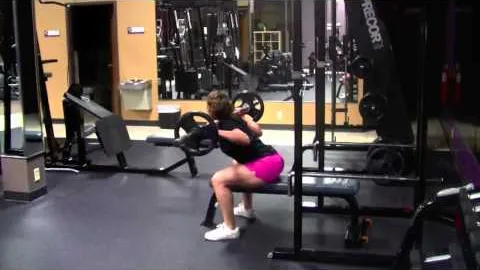

The barbell box squat is a highly effective exercise that targets multiple muscle groups in the lower body, including the quadriceps, glutes, and hamstrings. This exercise is a variation of the traditional back squat, but with the added benefit of utilizing a box or bench as a depth gauge, allowing for better form and control during the movement.
The barbell box squat is a compound exercise that engages several large muscle groups simultaneously. This allows for greater overall strength gains and muscle hypertrophy. The movement primarily targets the quadriceps, glutes, and hamstrings, leading to improved lower body strength and development.
Using a box or bench as a depth gauge provides a visual and tactile reference point for squat depth. This can be particularly beneficial for individuals who struggle with maintaining proper form during squats. By incorporating the box squat into your training routine, you can practice hitting the correct depth consistently, which helps to improve overall squat technique and control.
The barbell box squat is a safe exercise option for individuals with limited mobility or those recovering from lower body injuries. The use of a box allows for controlled and gradual descent, reducing the stress on vulnerable joints, such as the knees and hips. It also helps to promote proper alignment and posture, minimizing the risk of strain or injury.
The barbell box squat can be modified to focus on explosive power. By utilizing a lighter load and performing the exercise with an explosive concentric phase (ascent), you can develop greater power output and speed. This can be particularly beneficial for athletes involved in sports that require explosive lower body movements, such as sprinting, jumping, or weightlifting.
Performing the barbell box squat requires a good range of motion at the hips. Regularly incorporating this exercise into your training routine can help improve hip mobility and flexibility, which can have positive effects on overall functional movement and athleticism.
The barbell box squat is a highly effective exercise that targets multiple muscle groups in the lower body while providing various benefits, including increased strength and muscle mass, improved squat form and control, reduced risk of injury, enhanced explosive power, and increased hip mobility and flexibility. By incorporating this exercise into your training routine, you can enhance your lower body strength, improve your squat technique, and reap the numerous rewards of this versatile exercise.
If you're looking for a gym, fitness club or yoga studio, you've come to the right place.
You can find information about gyms in your area. Browse catalog of gyms and find gyms with classes which are you looking for.
On gym page you can find simple information like address, phone or website. You can find list of available classes. You can check availability of personal training or small group classes. On place page you can also see information about open hours.
You can find gyms near you with amenities, courts, studios and equipments.
Use our map to find gym at your city or district.
In Gym Navigator you can find list of exercises with movies for many body parts.
You can browse exercises catalog and find exercises the best of you.
You can also find exercises grouped into workout plans, which you can use to improve you body. Each routine show you exercises one by one and give you possibility to count you progress and count down rest time.